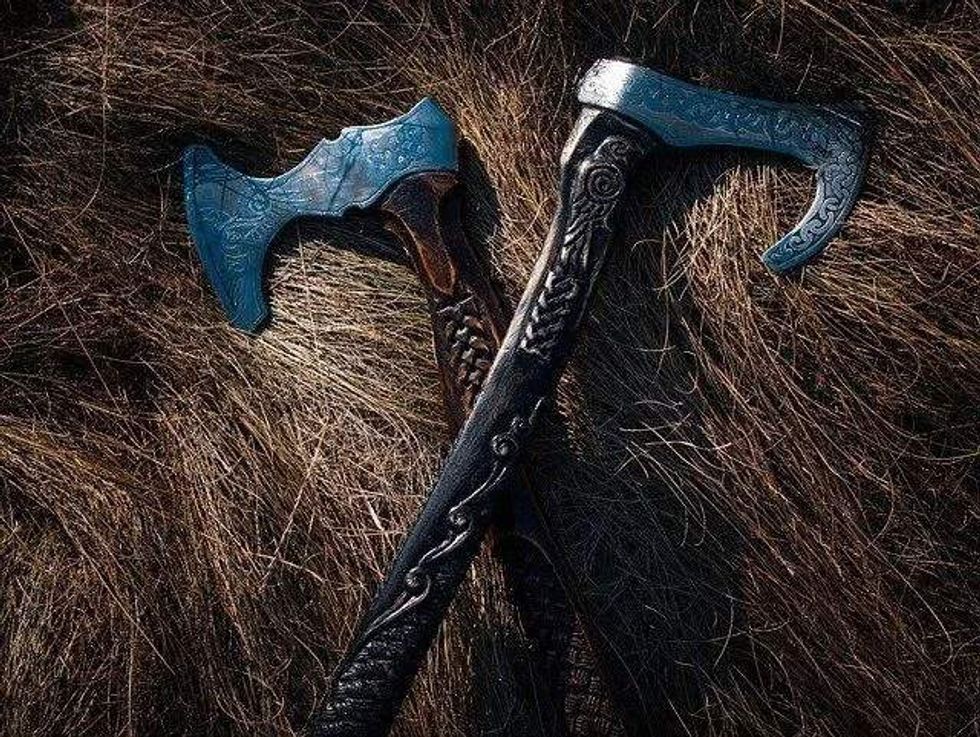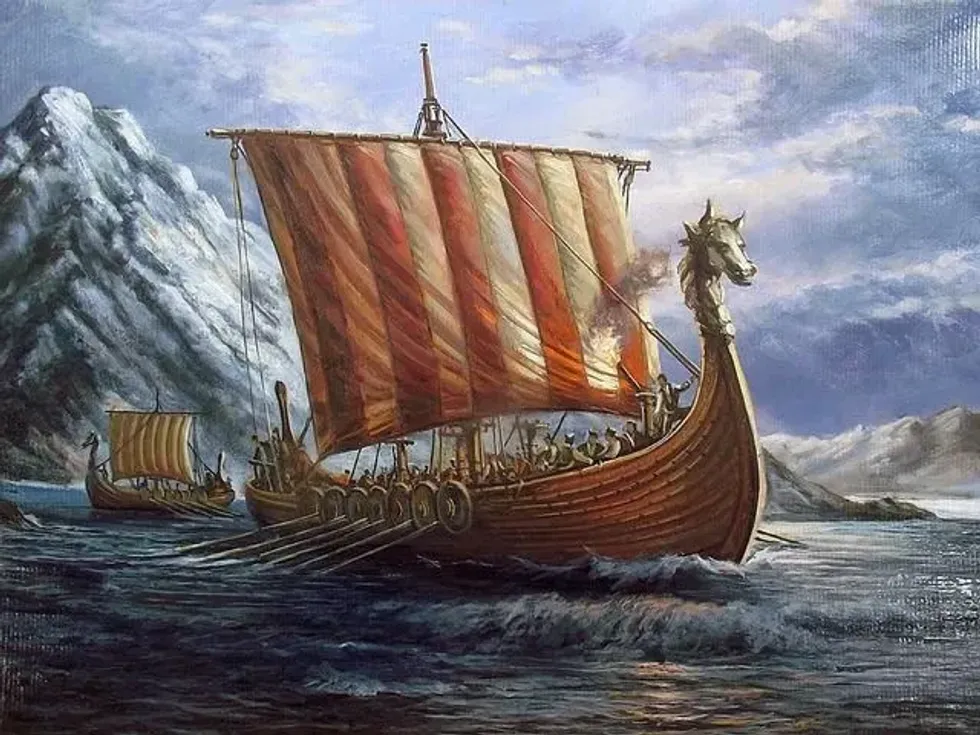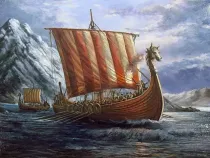Viking Culture Facts: Learn More About How The Norse Rulers Lived

Vikings sometimes referred to as the Norse men and women or 'noble savages', were a group of people belonging to Scandanavia, which consists of Norway, Denmark, and Sweden.
Vikings are primarily known for being warriors, and more infamously, raiders. The Viking Age started in 790 and continued till 1100, hence marking the eighth century as the beginning of the Viking era.
The Vikings were known to raid throughout Europe, making them one of the most feared groups of people. Being exceptional seafarers with advanced boats, the Vikings could travel to places like England and even North America and the Middle East.
The Vikings mainly raided in between harsh winters and summers and were known to loot anything from gold to clothing. The trail of brutality left behind by Viking looters was certainly unfortunate.
Though there is no single reason that can be ascribed to the Vikings being so brutal, it is worth mentioning that the Vikings used to raid by coordinating surprise attacks, which made any defense almost impossible. Such tactics did help them in gaining an upper hand.
Apart from raiding, the Vikings also settled in some of the countries they visited. This settlement may have been due to better availability of resources.
However, the ways in which Vikings influenced culture cannot be denied. This especially holds true for Viking literature and language, which has only served to enrich the literary depth of Europe.
To learn more fun facts about Viking culture, keep reading! You can also check out Viking clothing facts and Viking food facts.
Fun Facts About Viking Culture
Needless to say, the Viking culture was not only fascinating during its own time, but continues to intrigue historians and other people today. With a wide variety of sources collected through archaeological findings, researchers have been able to deduce the several cultural aspects of the Vikings.
Language - One of the easiest ways to understand the culture of any particular group is through the study of their literary creations. So, researchers have put considerable effort into analyzing and understanding the Viking language.
The Vikings spoke the Old Norse language. Even though there were minor variations, this was the primary spoken language covering all of the Viking lands.
The alphabetical letters of the Vikings were known as 'runes'. While initially, there were 24 runic alphabets, later it was cut down to 16.
Interestingly, much of the runic writings have been found on stones and a few other everyday objects, as opposed to on paper.
The runestones, which are stones with runic inscriptions, consisted of names of deceased Vikings or even the names of those who took part in expeditions. Additionally, there were runic inscriptions on everyday objects to mark the owner's name or the maker's name.
Did you know a comb was recovered belonging to the Viking Age, that had, 'I am a comb' inscribed on it? Clearly, the Vikings were not only using their alphabets to note down serious information!
Another aspect that can be deduced from the abundance of Viking language and especially of the Viking alphabets is that most Vikings were capable of reading. This paints quite a progressive and literate picture of the Viking society, which otherwise has been noted as being brutal and bloodthirsty.
Literature - The Viking or Norse literature is certainly worth mentioning. Vikings were the masters of storytelling and even created poetry. However, it is essential to note that, much of Viking literature was verbally passed down, before they were written down, well after the Viking era.
In terms of poetry, the Vikings had two kinds of poems. One was Eddic, while the other was Skaldic.
The former was written by anonymous poets and consisted of descriptions of Norse gods and other heroes of the Norse society. Skaldic poems, on the other hand, were written by poets called 'Skalds' and were created for notable Viking men and women, praising their deeds.
The Rök runestone is well-known for the Skaldic poetry inscribed on it, belonging to the ninth century.
Viking stories consisted of sagas, which incorporated family histories, political occurrences, and thrilling adventures. At the beginning of the 12th century, the verbal stories that were passed down for generations were finally written and recorded by the men of Iceland.
The 'Íslendingasögur', or 'Sagas of Icelanders', is a famous piece of literature that encompasses the story of ordinary Icelandic or Viking men, achieving extraordinary feats.
Even though it has been difficult to ascertain the authors who did pen down the Viking sagas, one such author to have been identified is Snorri Sturluson. He composed a book consisting of Norse mythology and a look into the language of poetry, titled, 'Snorra edda'.
Ships - One of the finest examples of the Norse culture is the Viking ship. The craftsmanship of Viking ships certainly gives an idea about the rich history of these raiders and warriors.
The longship is the most well-known and symbolic Viking ship. These ships were specifically designed for speed and helped these men of the middle ages to take part in wars and explorations.
The ships not only displayed the technical prowess of the Vikings but are also a fine example of Viking art.
A typical Viking ship was quite beautifully decorated, with intricate and detailed carvings on its stern. Dragon heads were also incorporated in the designs to give the ship an intimidating appearance.
However, the most important aspect of the ship was its sail, which was made from the finest homespun wool. Needless to say, the Vikings certainly did pay the closest of attention to the aesthetics of their ships!
Facts About Viking Traditions
The Viking traditions are worth noting as these influenced their day-to-day lives. Viking societies had strong traditional beliefs, which were influenced by their religion. Apart from customs which were taken part in collectively, each member of the society also had their private customs and traditions to follow.
One of the most prominent traditions of the Vikings took place when a baby was expected. It was common practice to sing songs to the mother and the unborn child to make them feel secure.
After the birth of the baby, on the ninth day, the father took part in a ceremony, where he placed his baby on his knee and sprinkled water on him.
This was a form of acceptance that was bestowed on the newest member of the clan. Additionally, Vikings named their babies after their ancestors or any Norse god.
There were traditions to be followed after the death of a Viking, as well. The Vikings buried their dead in graves or even in ships. Usually, the rich and aristocratic Vikings were buried with all their jewels and riches.
This provides a clue that the Vikings believed in the afterlife. Apart from burial, cremations were also carried out.
The Swedish Vikings were known to carry out cremations as opposed to burials. An eyewitness account of a ship with a dead body inside being set on fire has been recovered to testify the occurrence of ship cremations and burials.
Burial sites in several places, including Scotland, Iceland, Greenland, and Germany provide a hint about the Viking tradition related to death.
When it comes to marriage, most societies have intricate customs and rituals that they followed. The same holds true for the Vikings, who treated marriages as an important social institution.
Among the Vikings, weddings were not only essential for the bride and the groom, but also for the two families who were about to be bridged together.
One of the first customs was for the groom and his family to visit the bride. The main purpose of this visit was to offer a formal proposal to the bride, which when accepted, would lead to setting the date for the wedding in addition to assessing the amount of dowry to be given by the bride's family.
The Viking weddings were extraordinary affairs and consisted of feasts that lasted for several days.
In fact, a wedding that was shorter than three days was frowned upon. On the successful completion of the wedding, witnesses led the couple to their bed, in order to provide legitimacy for the wedding.
Another fascinating side of Viking traditions included ancestor worship. Many Vikings did take part in worshipping the deceased in their families in order to gain good fortune and prosperity.
The Vikings believed that they could inherit the luck that belonged to their ancestors if they made offerings. Hence, these warriors engaged in pleasing their ancestors and carried on the tradition of ancestor worshipping, which was, in fact, practiced by most pagans.

Facts About Viking's Religious Beliefs
The intricacies surrounding the Viking religion are certainly worth learning about. Their religion was also known as Old Norse religion or Norse Paganism.
Vikings had multiple Gods, and also took part in pagan worship. In fact, the Vikings were one of the last practitioners of polytheism and paganism in Scandinavia.
The Viking religious practices involved public rituals, and it has been ascertained that the Scandinavian kings of the time took part in conducting sacrifices in public. The Poetic Edda and Prose Edda serve as the most comprehensive sources for the Old Norse religion.
According to the religious views of the Vikings, a tree named Yggdrasill was the central establishment of the world. This tree was home to various animals, the most prominent being an eagle who inhabited the topmost branch of the tree.
The nine worlds of Viking mythology existed around Yggdrasill.
Out of the nine worlds, the names Asgard and Midgard, which were the home of the Gods and the home of the mortals, are worth mentioning. The frost giants, who inhabited Jotunheim, another one of the worlds, were designated as the main threat against the inhabitants of both Asgard and Midgard.
In the polytheistic Norse religion, the leader of all Gods was Odin. Odin was associated with a variety of aspects, including wisdom, battle, victory, poetry, death, and so on.
The other names of Odin were Woden, Wodan, and Wotan. Being the most prominent God of Scandinavia, Odin was particularly worshipped in Sweden. Odin's wife, the Goddess Frigg, was also worshipped as a symbol of marriage and fertility.
Did you know, that the names of the days, Wednesday and Friday, were given after Odin and Frigg, respectively? Together, Odin and Frigg had a son named Balder who was the God of light and joy.
However, Balder faced an early demise according to the myths, leaving Frigg to be a weeping mother. Apart from them, a number of other Gods, like Bragi, Loki, and Thor were worshipped. Overall, the Gods were divided into two groups, namely, Æsir and the Vanir.
In addition to the deities, other mythical characters also played a role in the religion of the Vikings. These characters included elves, giants, and dwarfs.
Eventually, most of the Vikings converted to Christianity, with Denmark being one of the first countries in Scandinavia to adopt Christianity.
Though there were attempts by missionaries to spread the message of Christ since the 700s, the successful Christianization of the Vikings took place much later, and by 1050 most of the Vikings identified as Christians.
This conversion was mainly triggered by the trade relations that the Vikings had established with primarily Christian countries of Europe. Apart from trade, political and social factors also influenced the Vikings to convert.
It is essential to mention that since the Vikings were polytheists, they did not resist the worship of Christ, as they chose to worship their old Gods, along with the new.
Facts About Viking Lifestyle
The history of Viking society depicts that it had an array of characters, which makes learning about the Viking lifestyle so much more interesting. Just like every other aspect of the Vikings, their day-to-day lives and activities not only bring great fascination for historians and researchers but also captivate everyone else's imagination.
A Viking settlement was quite simple, with villages consisting of homes made out of stone, wood, or mud. These homes were known as longhouses and were rectangular in shape.
The walls of the homes were made to be very thick in order to keep the cold out. Needless to say, the Vikings who were up on the social ladder had better and bigger homes, as compared to the middle class or poor ones.
The clothing worn by the Viking men and Viking women is definitely worth mentioning. Keeping the climate in mind, the Vikings chose to wear clothes made out of wool and animal skin.
However, the status of the individual did play a role in his/her clothing, so those who were at the top of the social hierarchy wore clothes of better quality, including silk. The Viking men wore shirts, trousers, and tunics on top.
On the other hand, the Viking women likely wore a thick underdress and a woolen strap dress on top of it.
The two layers of clothing were held together by brooches. You would be surprised to know, contrary to popular belief, Vikings did not wear horned helmets!
The diet of these warriors and raiders consisted mainly of meat, seafood, plant materials, milk, and buttermilk. The Icelandic horse and a variety of sheep breeds were some of the unique dietary inclusions in Viking society. Interestingly, the Vikings seasoned their food not just with homegrown spice, but also included spices like black pepper, which was imported.
One of the major ways of entertainment for the Vikings was through games and sports. Games like horse fighting, spear throwing, stone lifting, and wrestling were quite popular among the folks of that time. Apart from outdoor games, board games also kept the Vikings entertained. Researchers have hypothesized that the famous Isle of Lewis Chessmen were Viking creations.
Apart from clothing, food, and games, the common Vikings spent most of their time farming. The farmers harvested barley, wheat, and oats, apart from a number of vegetables and fruits. Livestock rearing and fishing were also carried out. Traders and specialized craftsmen also found important places in Viking society.
Here at Kidadl, we have carefully created lots of interesting family-friendly facts for everyone to enjoy! If you liked our suggestions for Viking culture facts: learn more about how the Norse rulers lived, then why not take a look at Viking battles facts or Viking axes facts?
We Want Your Photos!
More for You
Bachelor of Science specializing in Mass Communication.

Adekunle Olanrewaju JasonBachelor of Science specializing in Mass Communication.
Disclaimer
1) Kidadl is independent and to make our service free to you the reader we are supported by advertising. We hope you love our recommendations for products and services! What we suggest is selected independently by the Kidadl team. If you purchase using the Buy Now button we may earn a small commission. This does not influence our choices. Prices are correct and items are available at the time the article was published but we cannot guarantee that on the time of reading. Please note that Kidadl is a participant in the Amazon Services LLC Associates Program, an affiliate advertising program designed to provide a means for sites to earn advertising fees by advertising and linking to Amazon. We also link to other websites, but are not responsible for their content.
2) At Kidadl, we strive to recommend the very best activities and events. We will always aim to give you accurate information at the date of publication - however, information does change, so it’s important you do your own research, double-check and make the decision that is right for your family. We recognise that not all activities and ideas are appropriate for all children and families or in all circumstances. Our recommended activities are based on age but these are a guide. We recommend that these ideas are used as inspiration, that ideas are undertaken with appropriate adult supervision, and that each adult uses their own discretion and knowledge of their children to consider the safety and suitability. Kidadl cannot accept liability for the execution of these ideas, and parental supervision is advised at all times, as safety is paramount. Anyone using the information provided by Kidadl does so at their own risk and we can not accept liability if things go wrong.
3) Because we are an educational resource, we have quotes and facts about a range of historical and modern figures. We do not endorse the actions of or rhetoric of all the people included in these collections, but we think they are important for growing minds to learn about under the guidance of parents or guardians.







